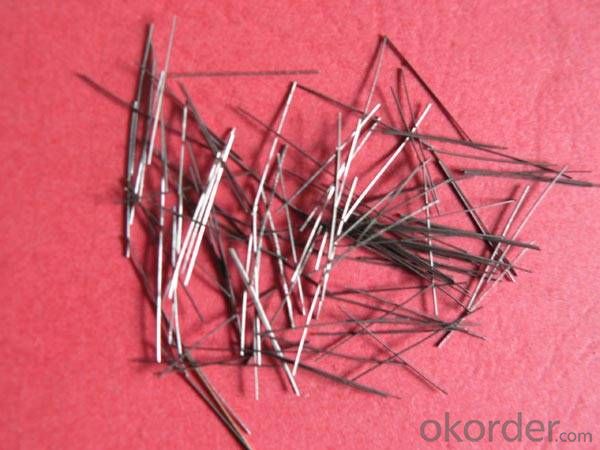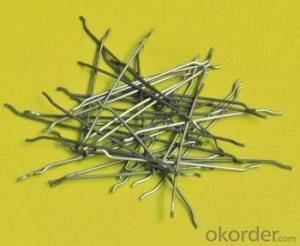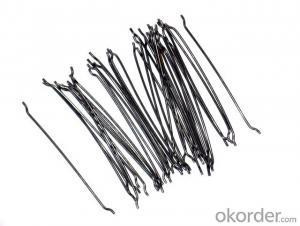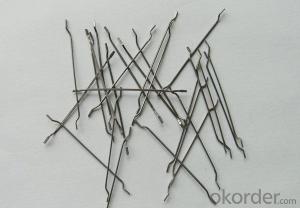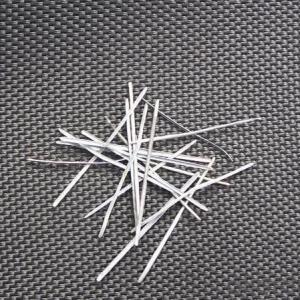Melt Extract Stainless Steel Fiber Reinforced High Tensile Strength Steel Fiber Construction New Material for Highway and Airport Pavement
- Loading Port:
- Tianjin
- Payment Terms:
- TT OR LC
- Min Order Qty:
- 5 kg
- Supply Capability:
- 30000 kg/month
OKorder Service Pledge
OKorder Financial Service
You Might Also Like
Quick Details
Place of Origin: Jiangsu, China (Mainland)
Model Number: HT-ST
Material: Steel
Specifications
Material: round cold drawn wire
Wire diameter: 1.0mm+-0.05mm
Fiber length: 35MM
Fiber diameter: 0.75mm
Tensile strength: ≥1100Mpa
Elongation at break: < 4%
Appearance:bright and clean wire
Package and storage
20KG damp-proof poly and paper composite bag. 50 bags/pallet.
The pallets should be protected against rain and snow.
Other specification:
Item | Diameter (mm) | Length (mm) | Aspect Radio (L/D) | Tensile Strength (MPa) |
G50/ 25BN | 0.5 | 25 | 50 | ≥1100 |
G60/ 30BN | 0.5 | 30 | 60 | ≥1100 |
G70/ 35BN | 0.5 | 35 | 70 | ≥1100 |
G70/ 35BN | 0.6 | 25 | 42 | ≥1100 |
G50/ 30BN | 0.6 | 30 | 50 | ≥1100 |
G58/ 35BN | 0.6 | 35 | 58 | ≥1100 |
G40/ 30BN | 0.75 | 30 | 40 | ≥1100 |
G47/ 35BN | 0.75 | 35 | 47 | ≥1100 |
G80/ 60BN | 0.75 | 60 | 80 | ≥1100 |
G38/ 30BN | 0.8 | 30 | 38 | ≥1100 |
G44/ 35BN | 0.8 | 35 | 44 | ≥1100 |
G75/ 60BN | 0.8 | 60 | 75 | ≥1100 |
G56/ 50BN | 0.9 | 50 | 56 | ≥1100 |
G67/ 60BN | 0.9 | 60 | 67 | ≥1100 |
G50/ 50BN | 1.0 | 50 | 50 | ≥1100 |
G60/ 60BN | 1.0 | 60 | 60 | ≥1100 |
Picture
Steel fiber straight type



FAQ
certificated: ISO 9001
Technical advantages of Daye steel fiber:
A. Improve mechanical performance of concrete
B. Provide uniform distribution throughout concrete with excellent mixing
C. No balling or caking by adopt correct mixing method
D. Reduce concrete volume
E.Save construction time and cost
F.Reduce excavation volume
G.Available for jointless floor.
- Q: Is melt extract stainless steel fiber compatible with different types of shotcrete curing methods?
- Yes, melt extract stainless steel fiber is compatible with different types of shotcrete curing methods. This type of fiber is often used in shotcrete applications to improve the strength, durability, and ductility of the concrete. It can be added to the shotcrete mix and sprayed onto various surfaces using wet or dry methods. Melt extract stainless steel fiber can be effectively used with different shotcrete curing methods including standard wet curing, accelerated curing, and polymer-based curing. It helps to reduce cracking and shrinkage of the shotcrete, improving its overall performance and longevity. Additionally, melt extract stainless steel fiber is highly resistant to corrosion and can withstand harsh environmental conditions, making it suitable for use in various shotcrete curing methods. It provides excellent bonding with the concrete matrix, enhancing its structural integrity and resistance to impact and abrasion. In summary, melt extract stainless steel fiber is compatible with different types of shotcrete curing methods and can significantly enhance the performance and durability of shotcrete applications.
- Q: What is the effect of melt extract stainless steel fiber on the impact resistance of concrete?
- The impact resistance of concrete is positively affected by the inclusion of melt extract stainless steel fibers. When these fibers are added to the concrete mix, they enhance the material's tensile strength and ductility, thereby increasing its resistance to impact and cracking. Acting as reinforcement, the fibers distribute the energy from an impact event throughout the concrete matrix, reducing stress concentration and preventing crack formation. Furthermore, the stainless steel composition of the fibers provides corrosion resistance, ensuring the long-term durability of the concrete structure. Overall, the addition of melt extract stainless steel fibers significantly improves concrete's impact resistance, making it a suitable choice for applications where heavy loads or potential impact events are anticipated.
- Q: What is the role of melt extract stainless steel fiber in refractory materials?
- The role of melt extract stainless steel fiber in refractory materials is primarily to enhance the mechanical properties and performance of the refractory material. Stainless steel fibers are added to the refractory mix to provide reinforcement and improve its resistance to thermal shock, cracking, and mechanical stress. The melt extract process ensures that the stainless steel fibers have a high degree of purity and uniformity, making them suitable for use in high-temperature applications. These fibers are typically added in small quantities to the refractory mix, but they significantly improve its strength, toughness, and resistance to wear and erosion. Stainless steel fibers also enhance the refractory material's thermal conductivity and dimensional stability, allowing it to withstand extreme temperatures without significant deformation or deterioration. They act as a reinforcement network within the refractory matrix, preventing the propagation of cracks and enhancing its overall durability. Furthermore, stainless steel fibers can improve the refractory material's resistance to chemical attack and corrosion, making it suitable for use in aggressive environments. They can also enhance the refractory's ability to retain heat, improving energy efficiency in various industrial applications. Overall, the addition of melt extract stainless steel fibers in refractory materials significantly enhances their mechanical strength, thermal stability, and resistance to various forms of degradation. This allows refractory materials to withstand harsh operating conditions and prolong their service life, making them essential in industries such as steelmaking, cement production, glass manufacturing, and petrochemical processing.
- Q: Can melt extract stainless steel fiber be used in concrete repair applications?
- Certainly! The utilization of melt extract stainless steel fiber is applicable in concrete repair applications. To enhance the mechanical properties and durability of concrete mixtures, it is customary to incorporate stainless steel fibers. The manufacturing process for melt extract stainless steel fibers involves a specialized technique that guarantees both high tensile strength and resistance to corrosion. These fibers effectively bolster the resistance to cracking, impact, and fatigue loading in repaired concrete structures. Moreover, they contribute to the improved bonding between the repaired concrete and the pre-existing concrete surface, thereby augmenting the overall integrity of the repaired area.
- Q: How does the addition of melt extract stainless steel fiber affect the toughness of concrete?
- Concrete's toughness is significantly improved by the addition of melt extract stainless steel fiber. This is achieved by incorporating stainless steel fibers into concrete mixtures, which enhances its crack resistance and overall durability. These fibers act as reinforcements within the concrete matrix, effectively boosting its tensile strength and preventing crack propagation. Specifically designed with a high aspect ratio and excellent bonding properties, melt extract stainless steel fibers ensure thorough distribution throughout the mixture and effective bridging of any microcracks that may form during curing or due to external factors. The inclusion of melt extract stainless steel fibers brings about a substantial enhancement in concrete toughness. The fibers reinforce the concrete, making it more resistant to impact, abrasion, and flexural stress. This increased toughness not only prolongs the lifespan of the concrete structure but also improves its resistance to environmental factors like freeze-thaw cycles and chemical degradation. Moreover, the addition of melt extract stainless steel fibers improves concrete's behavior after cracking. When cracks occur, the fibers help distribute stress more uniformly, reducing the width and length of the cracks. This prevents the cracks from expanding and compromising the structural integrity of the concrete. To summarize, the incorporation of melt extract stainless steel fiber greatly improves concrete's toughness by increasing its tensile strength, enhancing its crack resistance, and improving its overall durability. The result is a stronger and longer-lasting concrete structure that can withstand various external forces and environmental conditions.
- Q: How does melt extract stainless steel fiber affect the impact resistance of shotcrete?
- Shotcrete's impact resistance is greatly enhanced by melt extract stainless steel fiber. Shotcrete, which is typically used in construction and repair projects, is a high-strength concrete material that is sprayed onto surfaces. The inclusion of stainless steel fibers in shotcrete increases its tensile strength and toughness, rendering it highly resistant to impact and dynamic loads. Manufactured through a specialized process involving the melting of raw materials and their rapid extraction into thin, elongated fibers, melt extract stainless steel fibers are then incorporated into the shotcrete mix, ensuring even dispersion throughout the material. These fibers create a three-dimensional reinforcement network within the shotcrete, providing enhanced resistance to cracking and fragmentation when subjected to impact. The stainless steel fibers in shotcrete act as micro-reinforcements when confronted with impact forces, effectively absorbing and distributing the energy throughout the material. This prevents the formation and propagation of cracks, leading to improved impact resistance. The fibers also increase the shotcrete's ductility, allowing it to absorb more energy before failure. Furthermore, the corrosion resistance of stainless steel fibers ensures the long-term durability and performance of the shotcrete. These fibers do not rust or deteriorate over time, even in harsh environmental conditions, further enhancing the overall impact resistance of shotcrete. In conclusion, the addition of melt extract stainless steel fiber significantly enhances shotcrete's impact resistance. The fibers reinforce the material, prevent crack formation, and improve its toughness and ductility. Consequently, shotcrete with stainless steel fibers is an excellent choice for applications where impact resistance is of paramount importance, such as tunnel linings, retaining walls, and protective barriers.
- Q: Can melt extract stainless steel fiber be used in architectural facades or cladding systems?
- Yes, melt extract stainless steel fiber can be used in architectural facades or cladding systems. This type of fiber is specifically designed to enhance the strength and durability of concrete and other construction materials. It can be incorporated into the facade or cladding system to improve its structural integrity and resistance to cracking or deformation. Additionally, stainless steel fiber is highly resistant to corrosion, making it suitable for outdoor applications where it will be exposed to various weather conditions. Its versatility and ability to enhance the performance of architectural elements make melt extract stainless steel fiber a viable option for architectural facades or cladding systems.
- Q: Can melt extract stainless steel fiber be used in fiber-reinforced shotcrete?
- Yes, melt extract stainless steel fiber can be used in fiber-reinforced shotcrete. Stainless steel fibers are commonly used in shotcrete applications due to their high tensile strength, corrosion resistance, and durability. The melt extract process ensures uniform and consistent fiber properties, making it suitable for reinforcing shotcrete. The addition of stainless steel fibers to shotcrete enhances its mechanical properties, such as flexural and impact strength, crack resistance, and ductility. This improves the overall performance and longevity of the shotcrete structure. However, the specific application requirements, fiber dosage, and mix design should be considered to ensure proper and effective utilization of the stainless steel fibers in the fiber-reinforced shotcrete.
- Q: Does melt extract stainless steel fiber improve the resistance to acid attack in concrete?
- Yes, melt extract stainless steel fiber does improve the resistance to acid attack in concrete. The stainless steel fibers act as reinforcement, enhancing the concrete's durability and preventing acid penetration, thereby improving its resistance to acid attack.
- Q: What is the effect of melt extract stainless steel fiber on the flexural strength of shotcrete?
- The effect of melt extract stainless steel fiber on the flexural strength of shotcrete is that it significantly improves the overall strength and durability of the material. The addition of stainless steel fibers enhances the bonding between the shotcrete and the substrate, resulting in increased resistance to cracking, improved structural integrity, and higher flexural strength.
Send your message to us
Melt Extract Stainless Steel Fiber Reinforced High Tensile Strength Steel Fiber Construction New Material for Highway and Airport Pavement
- Loading Port:
- Tianjin
- Payment Terms:
- TT OR LC
- Min Order Qty:
- 5 kg
- Supply Capability:
- 30000 kg/month
OKorder Service Pledge
OKorder Financial Service
Similar products
Hot products
Hot Searches
Related keywords





